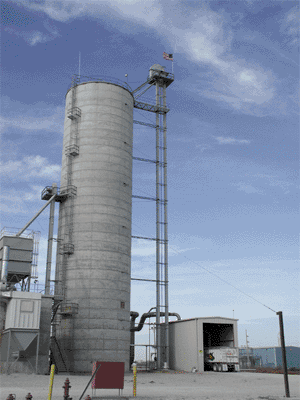|
|
In the movie, “Back
to the Future,” the professor used household trash as a gas alternative
to power the time machine. Finding a gasoline alternative might have seemed
like a futuristic idea then, but with the production and use of Ethanol-85,
it is becoming reality.
 Ethanol
is a high-octane liquid that works as a domestic and renewable fuel. It
is produced by the fermentation of plant sugars, usually from corn and
sorghum plants. Ethanol
is a high-octane liquid that works as a domestic and renewable fuel. It
is produced by the fermentation of plant sugars, usually from corn and
sorghum plants.
Why is ethanol production
good news for the American farmers?
Well, a benefit of
ethanol is that production of the fuel increases the monetary value of
feed grains grown by farmers. Ethanol production adds $4.5 billion to
the U.S. farm econ-omy every year. According to the United StatesDepartment
of Argiculture, ethanol production adds 30 cents to the value of a bushel
of corn.
According to the
Renewable Fuels Association, the production of ethanol fuel is the third
largest use of U.S. corn, utilizing seven percent of the corn crop. Locally,
the Dumas Cooperative and Hereford Cooperative ship corn and sorghum to
the closest ethanol plant in Portales, New Mexico.
Ray Watson, executive
director of the Texas Grain Sorghum Association believes with new legislation
and better understanding of the production of ethanol, more ethanol-run
plants will open.
“The Sorghum
and Corn associations are working together to make sure it is profitable
for producers,” said Watson.
The plant in Portales
has 44 employees and produces 15 million gallons of ethanol a year. Most
of the ethanol produced goes to California to be used as fuel for vehicles.
Most ethanol fuel, used as a gasoline alternative, is an 85 percent blend.
Water and organic
matter from the plants are mixed together and fermented to make ethanol.
After fermentation there are three layers remaining. The first is water
and small particles of grain and alcohol. It takes on a syrup consistency.
The second layer
is the remaining grain, which constitutes 17 percent of dry matter. The
third layer is the actual ethanol. It is the only layer sold and accounts
for exactly one-third of the 56 pounds of dry matter in the beginning.
Vehicles use a 5.7
percent ethanol blend, which totals out to 20 gallons of ethanol mixed
with one gallon of gasoline. A car loses efficiency if it is running on
pure ethanol. Watson said that is why most vehicles use E85.
An example of the
vehicles that are adapted for E85 is the Chevrolet Suburban. E85 has an
octane of approximately 105, as compared to unleaded gasoline, which is
a 96 octane. E85 also sells for approximately the same price as unleaded
gasoline. It is also safer for the environment.
 According
to the National Ethanol Vehicle Coalition, Ethanol-85 has the highest
oxygen content of any transportation fuel available, so it burns cleaner
than gasoline. This results in reduced production of smog and reduced
greenhouse gas emissions, like carbon dioxide. It is also non-toxic, water
soluble and biodegradable. According
to the National Ethanol Vehicle Coalition, Ethanol-85 has the highest
oxygen content of any transportation fuel available, so it burns cleaner
than gasoline. This results in reduced production of smog and reduced
greenhouse gas emissions, like carbon dioxide. It is also non-toxic, water
soluble and biodegradable.
“Since ethanol
is an alcohol, basically like Everclear, all you wil have if it leaks
into the water is some drunk fish,” said Watson.
Another benefit to
using Ethanol-85 as a fuel is good for the economy. E85 reduces America’s
dependence on foreign oil because the process of making ethanol uses U.S.
crops. Having ethanol in this country also ensures that having a shortage
of oil will not make gasoline prices increase.
If Ethanol becomes
more popular, there will soon be more plants producing ethanol. This means
there will be a need for workers for the plants. The National Ethanol
Vehicle Coalition projects that employment will be boosted by 200,000
jobs and the balance of trade will be improved by over $2 billion.
Currently there are
no ethanol production plants in Texas. Watson said there are discussions
taking place in the Texas legislature about approving plants. At this
point, there is no action in effect. He believes once people better understand
ethanol production and the benefits of it, plants will start to develop.
|
|
